Toe joint pain is a common problem. Toe pain most commonly affects the big toe, known as the hallux, not surprisingly seeing as when we walk, 90% of our body weight goes through the big toe. Toe pain may indicate a problem in the bones, soft tissues, nail or skin.
Here we will look at the ten most common causes of toe pain, the symptoms of causes of each as well as treatment and prevention strategies to help reduce and prevent pain in toes.
10 Common Causes of Toe Joint Pain
1) Gout
Gout is a common cause of big toe joint pain. The classic symptoms are sudden, intense pain, inflammation, redness, heat and tenderness. Gout most commonly affects the big toe, known as podagra, but can affect any of the other toes.
It is caused by high levels of uric acid in the body, produced as the body breaks down purines, a substance found in certain food and drink. This leads to the formation of urate crystals which can collect in the toe joint and cause inflammation.
Find out more about the common causes, symptoms and treatment options in the Gout Foot section.
2) Hammer/Mallet/Claw Toe
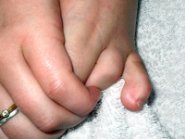
Another common cause of toe joint pain occurs when the small toe bones become misaligned. There are three joints in each of our toes (two in the big toe) which allow the toe to bend and move up and down and problems can develop in any of these. Depending on which joint is affected, the problem has a different name:
1) Hammer Toe: The middle toe joint bends down causing the middle of the toe to arch up. Most commonly affects the second toe
2) Mallet Toe: The distal toe joint (nearest the tip of the toe) bends down and prevents the toe from straightening properly.
3) Claw Toe: Both the middle and end toe joints bend down curling the toe into a claw shape. Often affects multiple toes at the same time
You can find out more about these common causes of sore toes in the Hammertoe section.
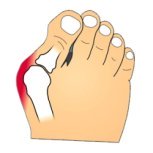
3) Bunions
Bunions, also known as hallux valgus, are a common cause of big toe joint pain. Gradually over time, the big toe shifts position with the top of the toe turning inwards, whilst the bottom of the toe starts to push outwards, forming a lump. Bunions most commonly affect females and are often due to wearing ill-fitting shoes that squash the toes.
Treatment options include stretching exercises, wearing toe spaces such as the yoga toe to stretch the toes apart, pain relief and in severe cases, surgery. Visit the Foot Bunion section to find out more about causes, symptoms, treatment and prevention.
4) Tennis Toe
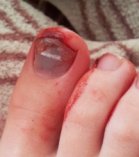
Tennis Toe is caused by repetitive damage, usually to the big toe, which causes blood to pool underneath the nail. Tennis Toe joint pain develops when activities cause the toe to repeatedly slam into the front edge of a shoe e.g. when quickly stopping or changing direction with running.
It causes throbbing big toe pain and the nail appears a reddish/black color. Tennis Toe can easily be avoided by following some simple prevention strategies. Visit the Tennis Toe section for more information about the common causes, symptoms, treatment and prevention options.
5) Turf Toe
Turf Toe is another common cause of big toe joint pain, which tends to affect sportsmen playing on hard, artificial surfaces. It is caused by hyperextension of the big toe (when it bends too far back) which damages the ligaments around the joint. It may be caused by a one-off event, or develop gradually over time from repeated trauma to the toe.
The result is big toe joint pain, stiffness and inflammation. Complete rest from aggravating activities is vital and symptoms tend to settle in about 4 weeks if treated properly.
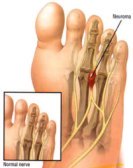
6) Morton’s Neuroma
Morton’s Neuroma is a condition affecting the nerves that run between the toes, causing pain, tingling, and numbness between your toes and underneath the foot. Many people complain that it feels like there is a small stone underneath their foot. Morton’s neuroma is caused by a thickening in the tissue which surrounds the nerve which irritates and compresses the nerve. This may be due to other foot problems such as bunions, hammertoe, and flat feet or wearing tight or high-heeled shoes.
It most commonly develops between the 3rd and 4th toe but can occur between the 2nd and 3rd toe. Treatment consists of rest, painkillers, injections, orthotics (shoe insoles) and occasionally surgery.
7) Ingrown Toenail
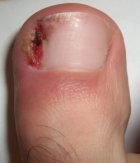
Ingrown toenails most commonly affect the big toe and develop when the curved edges at the side of the nail cut through the skin. The symptoms include big toe pain, swelling and redness. Left untreated, an infection may develop causing pus to ooze out of the wound. Ingrown toenails are usually caused by poor foot care, improper nail trimming, injury, wearing shoes that are too tight and even genetics – the shape of your toenail may make the problem more likely.
Treatment consists of appropriate nail trimming (ideally by a podiatrist), foot soaks, anti-inflammatories and gently pushing the skin away from the nail. In severe cases, surgery may be required. You can find out more about the common causes, symptoms, treatment and prevention options in the ingrown toe nail section.
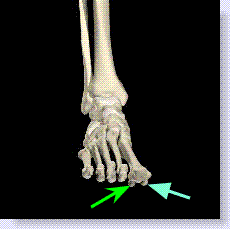
8) Sesamoiditis
Underneath the big toe are two small pea-shaped bones, known as sesamoid bones which sit inside the tendons that run to the big toe. They work like a pulley for the tendons to move the toe and play an important role in the push-off phase of walking.
Sesamoiditis occurs when there is inflammation of the sesamoid bones and surrounding tendons. This is usually caused by frequently wearing high-heeled shoes, activities that place lots of pressure through the ball of the foot such as ballet or suddenly increasing activity levels where you put more pressure on the ball of your foot such as running.
The most common symptoms are big toe pain, particularly underneath the toe and in the ball of the foot which develops gradually over time, comes and goes and gets worse when you are on your feet. It may be painful to move your big toe and occasionally there may be some swelling or bruising.
Treatment focuses on reducing the pressure through the area by wearing comfortable shoes, using padded shoe inserts or taping the big toe as well as reducing the big toe pain and inflammation with rest, regular ice treatment and occasionally a steroid injection.
9) Toe Arthritis
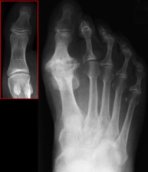
Arthritis is another common cause of toe joint pain. The most common place to get arthritis in the foot is at the base of the big toe in the metatarsophalangeal joint (MTPJ). The big toe is continually bending up and down as we walk making it prone to wear and tear. With arthritis, the cartilage that lines the MTPJ gets damages and osteophytes (small lumps of bone) form. This results in stiffening of the big toe, known as hallux rigidus.
Common symptoms include big toe joint pain, especially during the push-off phase of walking, inflammation, and stiffness limiting how much the big toe can bend up. A bunion may develop on the toe.
Toe arthritis may be linked with foot injuries or episodes of gout, but often develops with no obvious cause. Treatment consists of pain relief, ice, steroid injections and orthotics such as a rocker bar which fit on the sole of your shoe so you don’t have to bend the toe up when walking. If symptoms get progressively worse, surgery may be required to either trim some of the bone, fuse the joint or replace it altogether with a prosthesis.
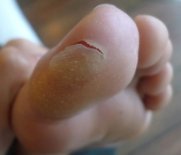
10) Blisters
Blisters on toes are a common, painful problem. Damage to the skin from sudden intense friction causes small pockets filled with fluid to form as the body tries to protect itself. Toe blisters often appear when wearing ill-fitting shoes, but can also develop in response to heat, chemicals or certain medical conditions.
Find out more about the different types of foot blisters, common causes and some great treatment and prevention methods for blister pain in toes.
Less Common Causes of Toe Pain
There are a number of other less common causes of toe joint pain:
1) Fractures: A break in one the toe bones either from trauma or repetitive stress
2) Blue Toe Syndrome: A condition where a blockage in the small blood vessels of the foot reduces blood and oxygen flow. The toes characteristically turn blue and are extremely painful
3) Vascular Disease: Narrowing of the arteries reducing the blood and oxygen flow to the legs and feet
4) Diabetes: People with diabetes are more susceptible to foot problems due to damage to the blood vessels and peripheral nerves
5) Capsulitis: Inflammation of the joint capsule, the fluid filled sac that surrounds the synovial joints of the toes
6) Tumors: Tumors in the foot bones are extremely rare accounting for 3-6% of all bone tumours
If your toes are in pain, Contact Achilles Podiatry for further evaluation and treatment.
Source: Foot Pain
